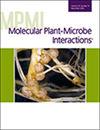Transcriptional Profiling and Genetic Mapping of Barley Responses to Bacterial Flagellin.
IF 3.4
3区 生物学
Q2 BIOCHEMISTRY & MOLECULAR BIOLOGY
Elizabeth K Brauer, Whynn Bosnich, Monique Power, Doris Luckert, Sarita Khanal, Nathan Liang, Reid James, Moatter Syed, Martin Charette, Danielle Wolfe, Arezo Pattang, Hannah Morrison, Stephanie Poncos, Melodie Laniel, James Tucker, Raja Khanal, Jean-Sébastien Parent, Bahram Samanfar
求助PDF
{"title":"Transcriptional Profiling and Genetic Mapping of Barley Responses to Bacterial Flagellin.","authors":"Elizabeth K Brauer, Whynn Bosnich, Monique Power, Doris Luckert, Sarita Khanal, Nathan Liang, Reid James, Moatter Syed, Martin Charette, Danielle Wolfe, Arezo Pattang, Hannah Morrison, Stephanie Poncos, Melodie Laniel, James Tucker, Raja Khanal, Jean-Sébastien Parent, Bahram Samanfar","doi":"10.1094/MPMI-12-24-0159-FI","DOIUrl":null,"url":null,"abstract":"<p><p>Diverse plant species detect bacterial flagellin using leucine-rich repeat receptor-like kinases to activate defense responses and promote resistance against bacterial invasion. In barley, the impact of flagellin on inducible defense responses has not been fully described. Here, we report that the flagellin-derived flg22 peptide induces callose, reactive oxygen species (ROS) bursts, and differential expression of 2,603 genes in barley. Cultivated barley genotypes produce different amplitudes of flg22-induced ROS bursts, indicating genetic variation for microbe-associated molecular pattern responses. Association mapping revealed a region on chromosome 7 underlying variation in flg22-induced ROS bursts, which contains 12 flg22-induced genes. Genotypes with higher flg22 responses had higher induced resistance to <i>Xanthomonas translucens</i> pv. <i>translucens</i> (<i>Xtt</i>), the causal organism of bacterial leaf streak. The flg22 region of <i>Xtt</i> flagellin evades detection in both barley and Arabidopsis, and a single amino acid change can restore immunogenicity of the peptide. Together, this work underlines the effectiveness of the flagellin-triggered defenses in promoting barley resistance to <i>Xtt</i>, which evades recognition of the flg22 region in its host. [Formula: see text]Copyright © 2025 His Majesty the King in Right of Canada, as represented by the Minister of Agriculture and Agri-Food Canada. This is an open access article distributed under the CC BY-NC-ND 4.0 International license.</p>","PeriodicalId":19009,"journal":{"name":"Molecular Plant-microbe Interactions","volume":" ","pages":"344-352"},"PeriodicalIF":3.4000,"publicationDate":"2025-03-01","publicationTypes":"Journal Article","fieldsOfStudy":null,"isOpenAccess":false,"openAccessPdf":"","citationCount":"0","resultStr":null,"platform":"Semanticscholar","paperid":null,"PeriodicalName":"Molecular Plant-microbe Interactions","FirstCategoryId":"99","ListUrlMain":"https://doi.org/10.1094/MPMI-12-24-0159-FI","RegionNum":3,"RegionCategory":"生物学","ArticlePicture":[],"TitleCN":null,"AbstractTextCN":null,"PMCID":null,"EPubDate":"2025/4/10 0:00:00","PubModel":"Epub","JCR":"Q2","JCRName":"BIOCHEMISTRY & MOLECULAR BIOLOGY","Score":null,"Total":0}
引用次数: 0
引用
批量引用
Abstract
Diverse plant species detect bacterial flagellin using leucine-rich repeat receptor-like kinases to activate defense responses and promote resistance against bacterial invasion. In barley, the impact of flagellin on inducible defense responses has not been fully described. Here, we report that the flagellin-derived flg22 peptide induces callose, reactive oxygen species (ROS) bursts, and differential expression of 2,603 genes in barley. Cultivated barley genotypes produce different amplitudes of flg22-induced ROS bursts, indicating genetic variation for microbe-associated molecular pattern responses. Association mapping revealed a region on chromosome 7 underlying variation in flg22-induced ROS bursts, which contains 12 flg22-induced genes. Genotypes with higher flg22 responses had higher induced resistance to Xanthomonas translucens pv. translucens (Xtt ), the causal organism of bacterial leaf streak. The flg22 region of Xtt flagellin evades detection in both barley and Arabidopsis, and a single amino acid change can restore immunogenicity of the peptide. Together, this work underlines the effectiveness of the flagellin-triggered defenses in promoting barley resistance to Xtt , which evades recognition of the flg22 region in its host. [Formula: see text]Copyright © 2025 His Majesty the King in Right of Canada, as represented by the Minister of Agriculture and Agri-Food Canada. This is an open access article distributed under the CC BY-NC-ND 4.0 International license.
大麦对细菌鞭毛蛋白反应的转录谱分析和遗传定位。
多种植物利用富含亮氨酸的重复受体样激酶(LRR - RLKs)检测细菌鞭毛蛋白,激活防御反应,促进对细菌入侵的抵抗力。在大麦中,鞭毛蛋白对诱导防御反应的影响尚未得到充分的描述。在这里,我们报道了鞭毛蛋白衍生的flg22肽诱导大麦中胼胝质、ROS爆发和2603基因的差异表达。栽培大麦基因型产生不同幅度的flg22诱导的ROS爆发,表明MAMP反应的遗传变异。关联图谱显示,在flg22诱导的ROS爆发中,7号染色体上存在一个潜在变异区域,该区域包含12个flg22诱导的基因。flg22反应高的基因型对半透明黄单胞菌具有较高的诱导抗性。半透明菌(Xtt),细菌性叶片斑纹的致病生物。Xtt鞭毛蛋白的flg22区在大麦和拟南芥中都可以逃避检测,一个氨基酸的改变可以恢复该肽的免疫原性。总之,这项工作强调了鞭毛蛋白触发的防御在促进大麦对Xtt的抗性方面的有效性,Xtt逃避了宿主flg22区域的识别。
本文章由计算机程序翻译,如有差异,请以英文原文为准。
来源期刊
期刊介绍:
Molecular Plant-Microbe Interactions® (MPMI) publishes fundamental and advanced applied research on the genetics, genomics, molecular biology, biochemistry, and biophysics of pathological, symbiotic, and associative interactions of microbes, insects, nematodes, or parasitic plants with plants.

 求助内容:
求助内容: 应助结果提醒方式:
应助结果提醒方式:


